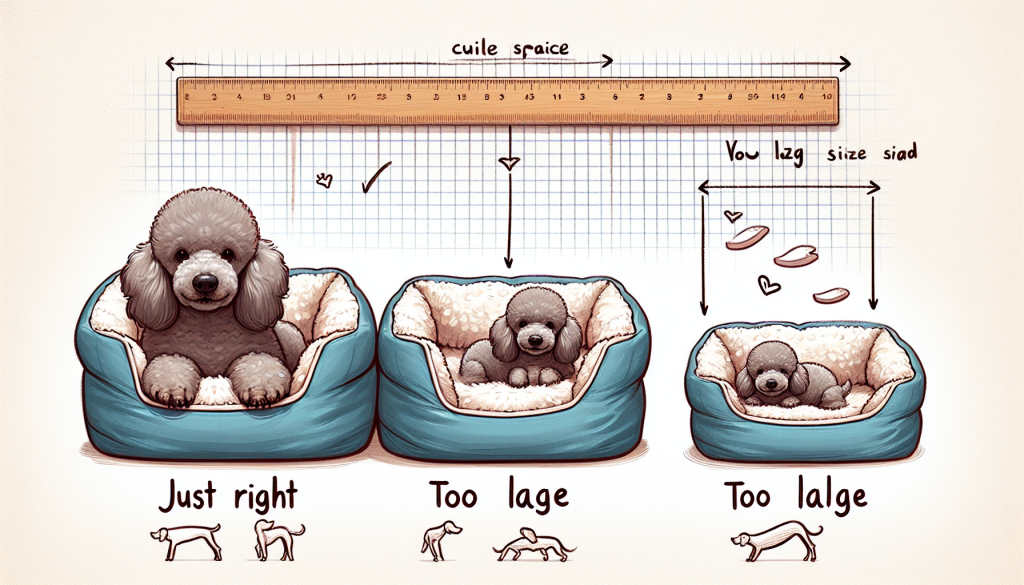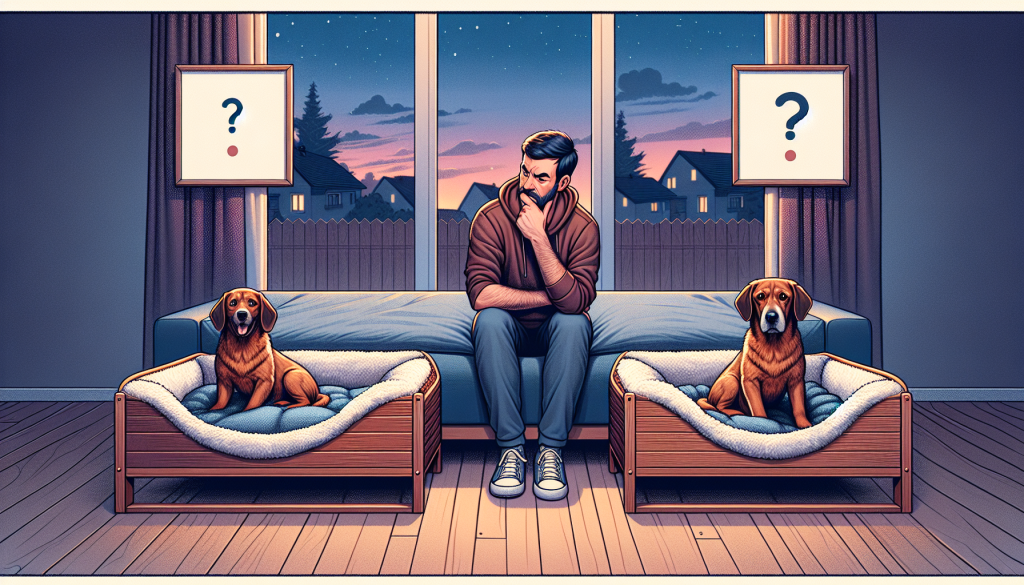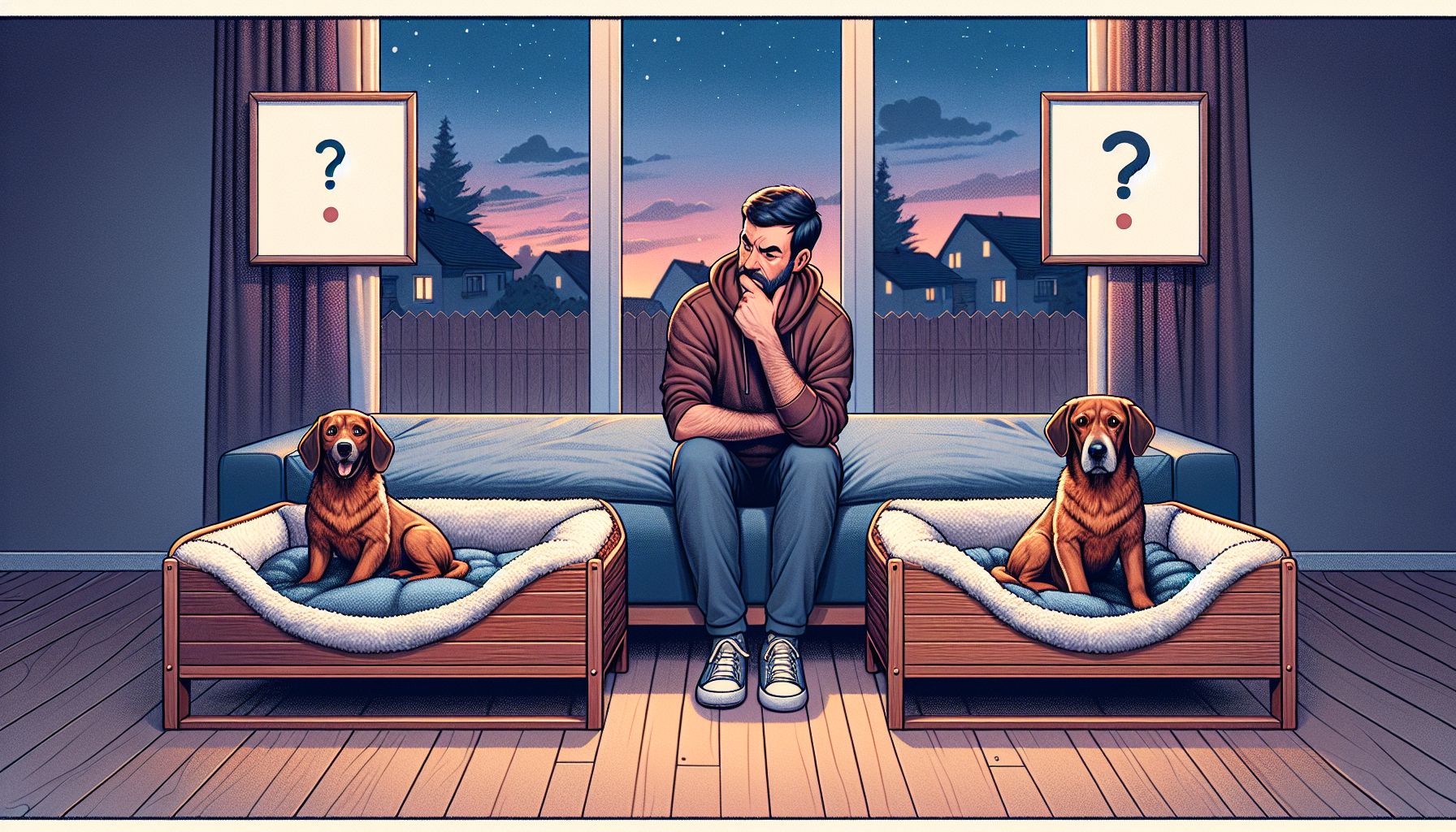Have you ever wondered if a dog bed can be too small for your furry friend? Well, it turns out that the size of a dog bed actually plays a crucial role in their comfort and overall well-being. While a cozy space can make your dog feel secure, a bed that is too small can lead to discomfort and even health issues. Whether you’re a new dog owner or have had your loyal companion for years, this article will explore the potential drawbacks of a small dog bed and provide useful tips on choosing the perfect size for your four-legged friend. So, let’s ensure your canine companion gets the restful sleep they deserve!

Signs that a dog bed may be too small
Dog struggling to fit on the bed
If your dog is struggling to fit on their bed, that is a clear sign that the bed may be too small for them. If they have to contort their body or squeeze themselves into a tight space, it can cause discomfort and restrict their movement. You may notice them constantly readjusting or trying to find a comfortable position.
Dog curls up tightly on the bed
Another indication that a dog bed may be too small is if your dog curls up tightly on it. Dogs naturally curl up when they sleep, but if they are forced to curl up tightly due to limited space, it can put unnecessary strain on their joints and muscles. They should have enough room to stretch out comfortably.
Dog’s body spills off the edges
If you find that your dog’s body extends beyond the edges of their bed, it is a clear sign that the bed is too small. Their limbs or even their entire body may hang off the sides, leaving them unsupported and uncomfortable. This can lead to stiffness or even injuries if they fall off the bed during sleep.
Dog frequently falls off the bed
Does your dog frequently fall off their bed while sleeping? If so, it could be because the bed is too small for them. When a bed is too narrow or short, dogs may accidentally roll or slide off while shifting positions during sleep. This can be a safety hazard and may even result in injuries.
Dog appears uncomfortable or restless on the bed
Pay attention to your dog’s behavior and body language while they are on their bed. If they seem restless, constantly repositioning themselves, or exhibiting signs of discomfort, it could be due to the bed being too small. Dogs need a comfortable and well-fitting bed to relax and get a good night’s sleep.
Why it’s important to have the right-sized dog bed
Promotes proper posture and alignment
Having the right-sized dog bed promotes proper posture and alignment for your furry friend. When a bed is too small, it can force your dog into uncomfortable positions, causing strain on their muscles and joints. On the other hand, a properly sized bed will allow them to lie down with their body in a natural, relaxed position, which is essential for their overall well-being.
Provides adequate support for joints and bones
Choosing the correct size of a dog bed is crucial in providing adequate support for your dog’s joints and bones. Proper support helps distribute their weight evenly, reducing the risk of developing joint problems, such as arthritis or dysplasia. A well-cushioned and appropriately sized bed can help alleviate pressure on sensitive areas and contribute to their long-term joint health.
Prevents pressure sores and calluses
When a dog bed is too small, it can lead to pressure sores and calluses forming on your dog’s body. Constantly rubbing against the edges of the bed or having their weight concentrated in a small area can cause skin irritations. By ensuring the right bed size, you can prevent these painful sores from forming and keep your dog comfortable.
Reduces the risk of developing musculoskeletal issues
Using a well-fitting dog bed can significantly reduce the risk of your pet developing musculoskeletal issues. Dogs, especially larger breeds, are prone to various bone and muscle conditions. By providing them with a bed that accommodates their size and breed, you can help minimize the strain on their body, supporting their overall musculoskeletal health.
Ensures a comfortable and restful sleep
A properly sized dog bed ensures that your furry friend can enjoy a comfortable and restful sleep. Just like humans, dogs need a good night’s sleep to recharge and stay healthy. By providing them with a spacious and cozy bed, you can create an environment where they can fully relax and rejuvenate, waking up refreshed and ready for the day ahead.
Factors to consider when choosing the right-sized dog bed
Dog’s size and breed
The size and breed of your dog are important factors to consider when choosing the right-sized bed. Larger breeds will require bigger beds to accommodate their size, while smaller breeds may be more comfortable on compact beds. It’s crucial to look for beds that are specifically designed for your dog’s weight and body proportions.
Dog’s sleeping habits and positions
Observing your dog’s sleeping habits and preferred positions can help determine the ideal bed size for them. Some dogs prefer to stretch out, while others like to curl up in a ball. If your dog likes to sprawl out, opt for a larger bed. If they prefer to curl up, a snug bed may be more suitable.
Available space in the room
Consider the available space in the room where the dog bed will be placed. You want to ensure that the bed fits comfortably without being too cramped. Measure the area and compare it to the dimensions of the bed you are considering.
Preference for a cozy or spacious sleeping area
Take into account your dog’s preference for a cozy or spacious sleeping area. Some dogs feel more secure and comfortable in snug spaces, while others may prefer a bit more room to spread out. The dog’s comfort should always be the priority when selecting the size of their bed.
Consideration of any health issues or special needs
If your dog has any health issues or special needs, consider these factors when choosing the right-sized bed. For example, dogs with arthritis may benefit from a larger bed with extra cushioning for joint support. If your dog requires orthopedic support, consult with your veterinarian for specific recommendations.
How to measure your dog for the correct bed size
Measure the dog’s length
To measure your dog’s length, measure from the base of their tail to the tip of their nose. This will give you an idea of the minimum length the bed should be to accommodate their entire body comfortably. Make sure to add a few extra inches to allow for movement and stretching.
Measure the dog’s width
To measure your dog’s width, measure across their widest point, typically their shoulders or hips. This measurement will help determine the width of the bed they require. Again, it’s essential to add a few extra inches to ensure they have enough space to lie down comfortably.
Consider the dog’s sleeping position
Take note of your dog’s preferred sleeping position. If they stretch out, measure from their nose to the tip of their back legs to determine the length needed for their bed. If they curl up, measure from their nose to the base of their tail to determine the length required.
Refer to the manufacturer’s sizing chart
Most reputable dog bed manufacturers provide sizing charts that correlate the bed size with the weight and breed of the dog. These charts can serve as a helpful guide in selecting the appropriate bed size for your furry friend. Compare your dog’s measurements with the sizing chart to find the best match.
Seek advice from a veterinarian or dog bed expert
If you’re still unsure about the correct size for your dog’s bed, seek advice from a veterinarian or a knowledgeable dog bed expert. They can provide insights based on your dog’s specific needs and help you make an informed decision. Remember, it’s always better to ask for assistance than to end up with an ill-fitting bed.

Common dog bed sizes and suitable breeds
Small dog beds (up to 25 lbs)
Small dog beds are suitable for breeds such as Chihuahuas, Yorkshire Terriers, and Shih Tzus. These beds are designed to provide a cozy and secure sleeping space for small breeds that prefer to curl up or sleep in a confined area.
Medium dog beds (26 – 45 lbs)
Medium dog beds are appropriate for breeds such as Beagles, Cocker Spaniels, and French Bulldogs. These beds accommodate medium-sized dogs that may prefer to stretch out or curl up while sleeping.
Large dog beds (46 – 70 lbs)
Large dog beds are suitable for breeds such as Labrador Retrievers, Golden Retrievers, and Boxers. These beds offer enough space for larger breeds to stretch out comfortably and provide support for their joints and muscles.
Extra-large dog beds (71+ lbs)
Extra-large dog beds are designed for giant breeds such as Great Danes, Mastiffs, and Saint Bernards. These beds provide ample space for these larger-than-life dogs to sprawl out and ensure their body is adequately supported during sleep.
Adjusting the dog bed size as the dog grows
Choose a bed with adjustable sides or panels
One option for adjusting the dog bed size as your dog grows is to choose a bed with adjustable sides or panels. These beds can be expanded or contracted to accommodate a growing puppy or accommodate multiple dogs of different sizes.
Opt for a larger bed to accommodate growth
If you have a young puppy, it’s wise to opt for a larger bed from the start to accommodate their growth. Puppies grow quickly, and investing in a bed that will last them into adulthood can save you from constantly needing to replace smaller beds as they outgrow them.
Consider purchasing a crate with a removable divider
If you use a crate for your dog, consider purchasing one with a removable divider. This way, you can adjust the space inside the crate as your dog grows. Start with a smaller area when they are a puppy and gradually increase it as they get bigger.
Upgrade to a bigger bed when necessary
As your dog grows, regularly assess their bed and upgrade to a larger size when necessary. A bed should always allow them enough room to move and stretch comfortably. Keep an eye on their behavior and sleeping positions to determine when it’s time for an upgrade.
How to make a small dog bed more comfortable
Add extra padding or a mattress topper
If you have a small dog bed that you want to make more comfortable, consider adding extra padding or a mattress topper. These additions can provide additional cushioning and support, creating a more plush and cozy sleeping surface for your furry friend.
Use a blanket or towel for extra warmth and softness
Another way to enhance the comfort of a small dog bed is to use a blanket or towel. Layering a soft and warm fabric on top of the bed can make it more inviting and cozy for your dog. Additionally, it’s much easier to clean a removable blanket than the entire bed.
Provide a supportive pillow or bolster for neck and head
To provide extra support for your dog’s neck and head, add a supportive pillow or bolster to their small bed. This will help align their spine and relieve tension in their neck muscles. Look for pillows or bolsters specifically designed for dogs and choose one that suits their sleeping position.
Ensure the bed is placed in a quiet and cozy spot
The location of the bed can greatly impact your dog’s comfort. Make sure the bed is placed in a quiet and cozy spot, away from high-traffic areas or sources of noise. Dogs enjoy having their own designated space where they can relax undisturbed.
Keep the bed clean and free from odors
Regularly clean the small dog bed to keep it fresh and free from odors. Dirt, hair, and odors can accumulate over time, making the bed less comfortable for your pet. Follow the manufacturer’s instructions for cleaning or consult a professional cleaner if needed.
Potential risks of using a small dog bed
Promoting discomfort and poor sleep quality
Using a small dog bed can promote discomfort and poor sleep quality for your furry friend. If their bed is too cramped or lacks sufficient support, they may struggle to find a comfortable position, leading to disrupted sleep. Over time, this can impact their overall well-being and behavior.
Increasing the risk of joint and muscle issues
Inadequate space and support in a small dog bed can increase the risk of joint and muscle issues. Dogs that constantly have to squeeze themselves into a bed that is too small may experience strain on their joints, leading to inflammation and potential long-term problems such as arthritis.
Causing pressure sores and skin irritation
When a dog bed is too small, it can cause pressure sores and skin irritation. Constant rubbing against the edges or having body weight concentrated in a small area can create friction and redness on their skin. This can be both uncomfortable and painful for your furry friend.
Creating long-term health problems for the dog
Using a small bed that is not suitable for your dog’s size and breed can create long-term health problems. From musculoskeletal issues to poor posture and circulation problems, the physical strain caused by an ill-fitting bed can have serious consequences on your dog’s overall health.
Negatively impacting the dog’s overall well-being
An uncomfortable and ill-fitting bed can negatively impact your dog’s overall well-being. Dogs need quality sleep and a comfortable resting place to thrive physically and mentally. If their bed is causing discomfort or poor sleep quality, it may lead to behavioral changes such as irritability, restlessness, or even aggression.
When to consider replacing a small dog bed
When the dog no longer fits comfortably on the bed
If your dog no longer fits comfortably on their bed, it’s time to consider replacing it. As dogs grow or gain weight over time, their bed may become too small to provide proper support and comfort. Regularly assess their bed and ensure they have enough space to stretch out and lie down comfortably.
When the dog starts showing signs of discomfort or restlessness
Pay attention to your dog’s behavior and any signs of discomfort or restlessness while on their bed. If they are constantly shifting or unable to find a comfortable position, it may be an indication that the bed is too small. A properly sized bed should promote relaxation and restful sleep.
When the dog’s size exceeds the bed’s capacity
As your dog grows, their size may exceed the capacity of their current bed. Check the weight and size limits specified by the manufacturer and make sure the bed can adequately accommodate your dog. A bed that is too small can lead to increased strain on their body and potential health problems.
When the bed shows signs of wear and tear
Dogs can be rough on their beds, especially if they like to dig or chew. If you notice signs of wear and tear, such as frayed fabric, flattened padding, or exposed filling, it’s time to replace the bed. Damaged beds can be uncomfortable and potentially unsafe for your furry friend.
When the dog’s health or sleeping habits change
Changes in your dog’s health or sleeping habits may also warrant a new bed. For example, if your dog develops arthritis or experiences changes in mobility, they may require an orthopedic bed with additional support. Stay attuned to your dog’s needs and make adjustments to their bed accordingly.
Conclusion
Choosing the right-sized dog bed is crucial for your pet’s comfort, well-being, and overall health. By paying attention to signs that a bed is too small and considering factors like size, breed, and sleeping habits, you can ensure a comfortable and restful sleep for your furry friend. Regularly measure and assess the bed, making adjustments or replacements as necessary. Remember to prioritize quality and suitability over aesthetics when selecting a dog bed, as your dog’s comfort should always come first.
